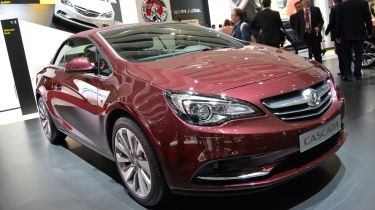Vauxhall Cascada 2.0 CDTi
The new petrol engine has grabbed the headlines, but now we try the diesel Vauxhall Cascada

If economy is a priority, this diesel Cascada is better than the petrol car. On paper, it’s 15.1mpg more efficient, but the gains could be better than that thanks to extra torque and a manual gearbox, which help keep revs low. On the other hand, the petrol is smoother. Whichever you choose, you’re getting a sophisticated and capable four-seat convertible.
The Vauxhall Cascada convertible is the first car to use the company’s new 1.6-litre petrol engine. But there’s also a 2.0-litre diesel if you want similar performance with better fuel economy.
On paper, the two engines are evenly matched – they have the same 135mph top speed, while the petrol car is four-tenths faster from 0-60mph (setting a time of 9.2 seconds) even with an auto. What the figures don’t show is how 70Nm more torque (350Nm in total) gives the diesel more urgent in-gear acceleration.
Even so, neither engine is a sparkling performer. The diesel produces a lot of rattly noise, particularly at low revs. It also has a narrow power band, not coming on boost until nearly 2,000rpm and running out of puff just below 4,000rpm. That means you have to work the six-speed box harder than you’d expect to counter the engine’s inflexibility.
Used - available now

2023 Ford
Kuga
47,524 milesAutomaticPetrol2.5L
Cash £19,300
2020 Land Rover
Range Rover Velar
63,000 milesAutomaticDiesel3.0L
Cash £25,995
2020 BMW
X3
48,000 milesAutomaticDiesel2.0L
Cash £23,995
2020 BMW
X3
40,700 milesAutomaticDiesel3.0L
Cash £33,995At higher speeds, the diesel quietens down and the Cascada becomes the smooth and refined cruiser it was designed to be. It has 18-inch alloys, but fortunately the ride is supple, soaking up bumps and smoothing out all but the worst potholes.
Our car came with adaptive FlexRide adjustable dampers, which are worth considering if comfort is your priority. They also ensure that ride quality isn’t compromised should you choose one of the even larger wheel sizes on the options list.
Although Vauxhall is keen to stress that the Cascada isn’t meant to be a sports car, it still handles pretty well. There’s no real steering feel, but the front responds quickly and accurately to the driver’s inputs. You feel the extra weight of the diesel over the petrol engine in the car’s nose, but the brakes are more than capable of hauling that mass to a stop.
The Cascada’s exterior design mixes familiar Vauxhall styling cues from the Astra with the increased length of the Insignia. It lacks the clean lines of the Audi A5 Cabriolet, which is a similar size, but it’s still attractive and much cheaper than the Audi equivalent.
Inside, the centre console is a real button-fest, but while the A-pillars hamper your view out the front, the driving position is decent.
Our test car had an optional acoustic roof, which adds a layer of insulation between the canvas outer and fabric inner layer. When raised, it cuts out wind, engine and road noise well, but it can’t block everything, so an idling truck or shouting pedestrian still sounds surprisingly loud.
With the roof down, the car stays stiff, and all occupants are well protected from buffeting as long as you keep the windows up on the motorway. But taller rear seat passengers get blown about, limiting how long you can go four-up with the hood folded.







